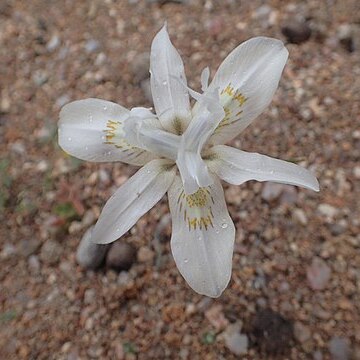Plants (60-)120-200 mm high. Corm 7-16 mm diam.; tunics usually pale, rarely dark brown, of fine to medium fibres. Stem slender, up to 1 mm diam., with long basal internode, few-to several-branched, sheathing leaves 12-20 mm long, green, becoming dry above. Foliage leaves usually 2, inserted at first above-ground node, subopposite, occasionally solitary, linear-filiform, narrowly channelled, 1-2 mm wide, subequal or unequal in length, occasionally loosely spiralled distally. Rhipidial spathes green or becoming dry distally, inner 20-35(-40) mm long, outer ± 1/3-1/2 as long. Flowers fugaceous, white, sometimes shaded blue or pink, or blue-mauve, rarely violet or purple, vanilla-scented, outer tepal limbs with yellow nectar guides at bases, limbs of both whorls reflexed up to 40º; tepals lanceolate, outer 20-30(-35) x 8-12 mm, claws ± 8 mm long; inner 18-30 x 5-7 mm. Filaments 5-6 mm long, united in lower half; anthers 4-6 mm long, usually white; pollen white. Ovary narrowly ellipsoid, 8-11 mm long, included, style branches 8-10 mm long, crests lanceolate 8-15 mm long. Capsules 8-13(-15) mm long, shortly beaked.
More
Like M. fugax but plants smaller, stem slender, leaves usually ± filiform, flowers small, blue, violet, or white, opening early afternoon. Mostly Aug.-Sept.
Like M. fugax but plants smaller, stem slender, leaves 2, usually ± filiform, flowers small, blue, violet, or white, opening early afternoon.

